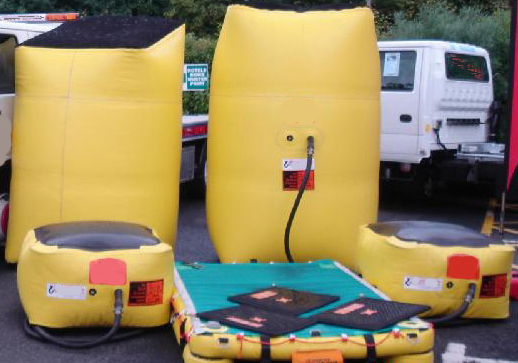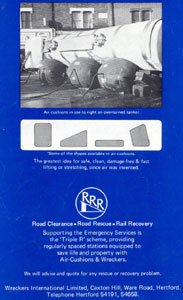
The principle of moving, lifting or rolling large heavy loads by the use of low and high pressure air cushions has been developed by many years of tests and improvements conducted on the original air cushion invention. For rescue work the wide experience of fire and rescue services throughout the world, has resulted in the production of a range of air cushions which when deflated can be inserted into gaps of only 25mm and yet, when inflated, can produce sufficient movement to effect the release of trapped casualties. For recovery work the vertical lift of an air cushion, when inserted under a load, can have a lift and roll effect of almost twice the lifting capacity of the air cushion.
Rescue organisations throughout the world have already adopted the smaller range of air cushions, both high and low pressure but as gross vehicle weights increase, the need for greater lifts has become more apparent. Specialised cushions have been designed for lifting of railway coaches and carriages, aeroplanes,underwater salvage,tankers and containers, down to the very simple operation of lifting the front or rear of vehicles in order to change wheels or to assist in raising a vehicle to pick it up with an underlift.
Air Cushions may be inflated either from an air bottle or from a purpose built compressor. Air is supplied via a valve block incorporating overload safety release valves for each cushion so that when the maximum pressure is reached the safety device takes over. Should leaks occur through carelessness, in the sidewalls, these can be repaired on site in a few minutes.
For rescue work the use of air cushions are unlimited, but the basic purpose is always the same; to increase the size of the gap by some mm. in order to release trapped casualties. Generally speaking, in all accidents a casualty can be moved through a gap of 300mm. And this can be produced in a few minutes.
Case histories where air cushions have effected rescues include persons trapped under overturned vehicles, fallen trees, collapsed steelwork or scaffolding, trenches or casualties trapped in tunnels, against walls or in railway accidents.
The cushions are light and can be carried by any rescuer, coupled to normal breathing cylinders, producing a highly mobile rescue combination.
For recovery they overcome one of the major problems today bought about by the increasing size of vehicles on the road. Coupled with their delicate structure designed to produce lower unladen weights but in turn, leading to very considerable problems for normal recovery equipment and operators. In the case of such vehicles as tankers, high sided vehicles and containers where it is necessary to effect the initial lifting to avoid the cutting action of wire ropes, chains and in some cases nylon straps, the insertion of air cushions will provide the initial lift of some 900mm to 1200mm enabling the recovery to be completed in the normal way without further damage to the vehicle.
Each cushion, when deflated, requires only a 300mm gap and a combination of small cushions with the larger cushions, enables loads of 40 to 50 tonnes to be lifted in a matter of minutes. Seen here are a selection of photographs taken over many years showing air cushions in use right up to their use today.















